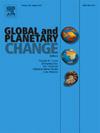1997 年和 2015 年厄尔尼诺现象对印度夏季季风降雨量的不同影响:南半球的作用
IF 4
1区 地球科学
Q1 GEOGRAPHY, PHYSICAL
引用次数: 0
摘要
本研究全面分析了 1997 年和 2015 年历史上与印度夏季季风(ISM)降雨相关的厄尔尼诺现象所造成的对比影响。与 2015 年的厄尔尼诺现象相比,1997 年出现了强烈的东南-西北向冷海洋表面温度(SST)异常,其空间范围从西南太平洋扩展到东南印度洋(SEIO)。显然,这些异常与南太平洋辐合带(澳大利亚南部)气旋(反气旋)环流之间的相互作用密切相关。2015 年,"莫多基 II "与典型厄尔尼诺现象的结合引发了整个印度洋-西太平洋(IWP)的非对称赤道环流,从而通过对流层和平流层路径机制刺激了南方环流模式(SAM)。此外,2015 年,南环流模式影响了印度洋,进而影响了印度洋降雨。与澳大利亚南部上空反气旋西移相关的正南环流模式改变了环流,在南印度洋上空诱发西风,从而抑制了印度洋偶极子(IOD),并诱发了2015年印度上空的干旱状况。此外,作为北方夏季 IOD 强度指标的澳大利亚指数,是南半球中纬度地区普遍存在的一个桥接因子。这项研究的结果表明,南半球大气流动及其在调节印度洋地区从而影响 ISM 降雨量方面的作用具有复杂的相互作用。更好地了解这些基本机制可以大大提高季风变化和极端天气的预测能力和预测结果。本文章由计算机程序翻译,如有差异,请以英文原文为准。
Contrasting influence of the 1997 and 2015 El Niño on the Indian Summer Monsoon Rainfall: Role of the Southern Hemisphere
This study provides comprehensive analysis on the contrasting effects caused by the 1997 and 2015 historical El Niño events linked with the Indian Summer Monsoon (ISM) rainfall. The presence of strong southeast-northwest oriented cold Sea Surface Temperature (SST) anomalies during 1997, that spatially extended from southwest Pacific to Southeast Indian Ocean (SEIO) in comparison to the 2015 event is the robust feature. Evidently, these anomalies are closely related to interaction between cyclonic (anticyclonic) circulation over South Pacific Convergence Zone (south Australia). During 2015, the conjunction of Modoki II and classical El Niño triggered an asymmetrical equatorial circulation throughout the Indo-western Pacific (IWP) and thereby stimulated the Southern Annular Mode (SAM) through troposphere and stratospheric pathway mechanism. In addition, in 2015, SAM impacted the Indian Ocean, which intern affected ISM rainfall. Positive SAM associated with westward shift of anticyclone over south of Australia alters the circulation by inducing westerly winds over the South Indian Ocean, thereby suppressing Indian Ocean Dipole (IOD), and inducing drought conditions over India during 2015. Moreover, the AUS index, an indicator for IOD strength in boreal summer, is a bridging factor prevalent over mid-latitude regions in the southern hemisphere. Results from this study indicate the complex interaction of southern hemisphere atmospheric flow and its role in modulating the Indian Ocean region thereby ISM rainfall. A better understanding of these underlying mechanism can significantly enhance the predictive skills and projections of monsoon variability and extremes.
求助全文
通过发布文献求助,成功后即可免费获取论文全文。
去求助
来源期刊

Global and Planetary Change
地学天文-地球科学综合
CiteScore
7.40
自引率
10.30%
发文量
226
审稿时长
63 days
期刊介绍:
The objective of the journal Global and Planetary Change is to provide a multi-disciplinary overview of the processes taking place in the Earth System and involved in planetary change over time. The journal focuses on records of the past and current state of the earth system, and future scenarios , and their link to global environmental change. Regional or process-oriented studies are welcome if they discuss global implications. Topics include, but are not limited to, changes in the dynamics and composition of the atmosphere, oceans and cryosphere, as well as climate change, sea level variation, observations/modelling of Earth processes from deep to (near-)surface and their coupling, global ecology, biogeography and the resilience/thresholds in ecosystems.
Key criteria for the consideration of manuscripts are (a) the relevance for the global scientific community and/or (b) the wider implications for global scale problems, preferably combined with (c) having a significance beyond a single discipline. A clear focus on key processes associated with planetary scale change is strongly encouraged.
Manuscripts can be submitted as either research contributions or as a review article. Every effort should be made towards the presentation of research outcomes in an understandable way for a broad readership.
 求助内容:
求助内容: 应助结果提醒方式:
应助结果提醒方式:


